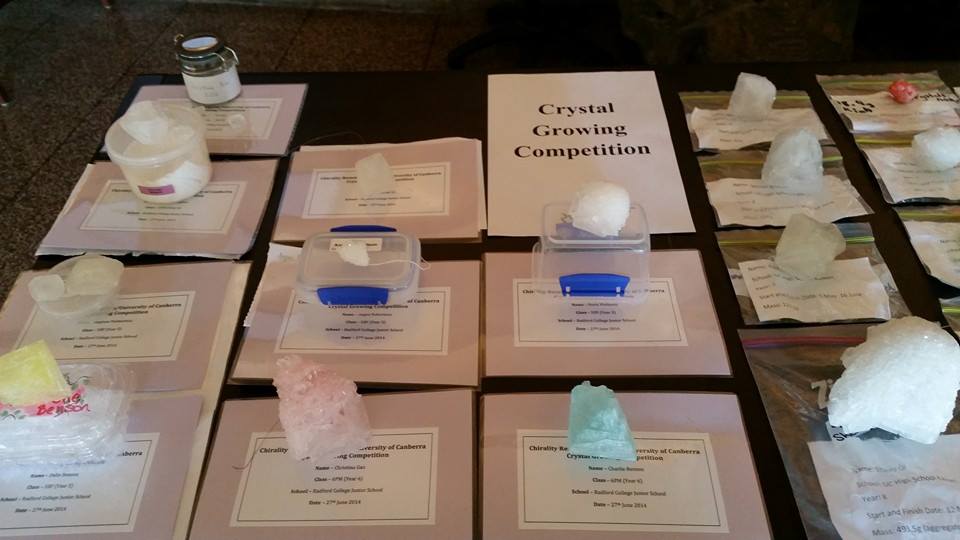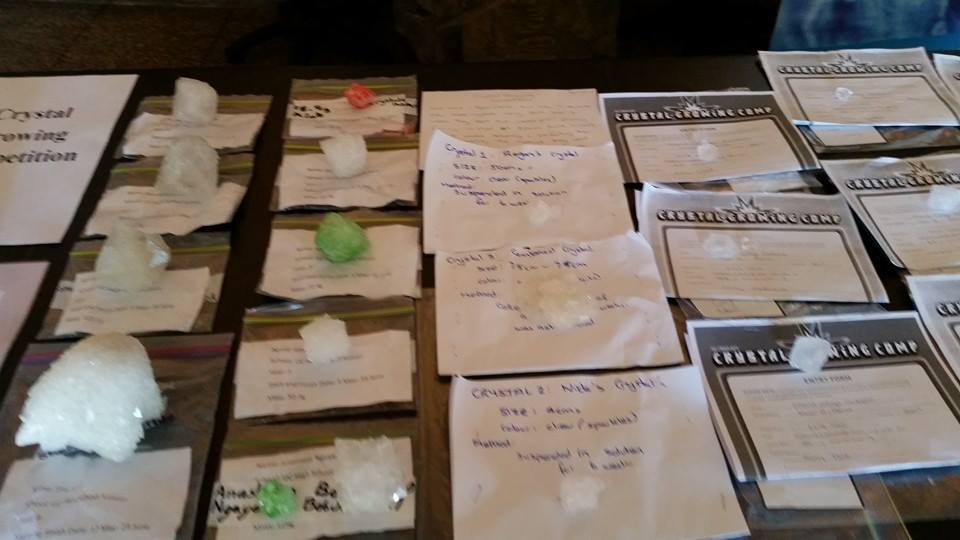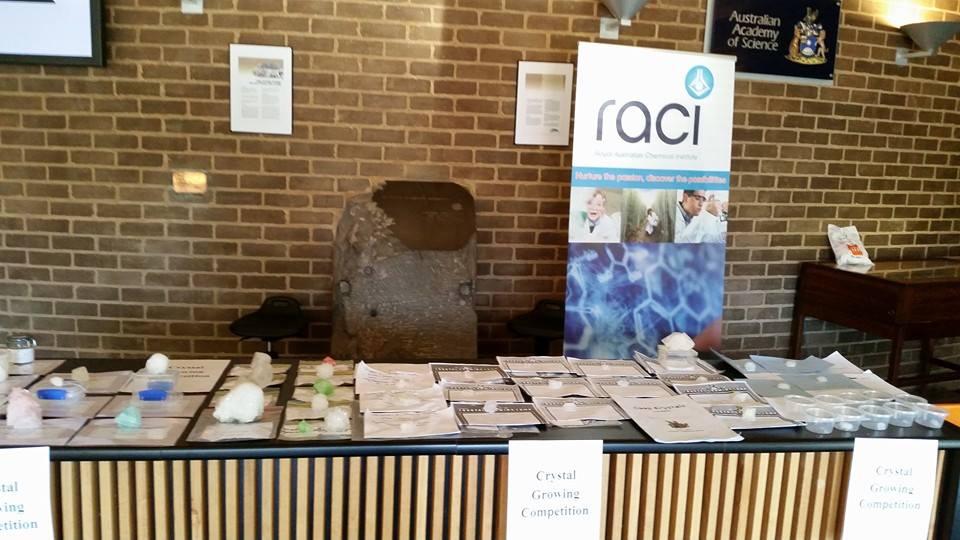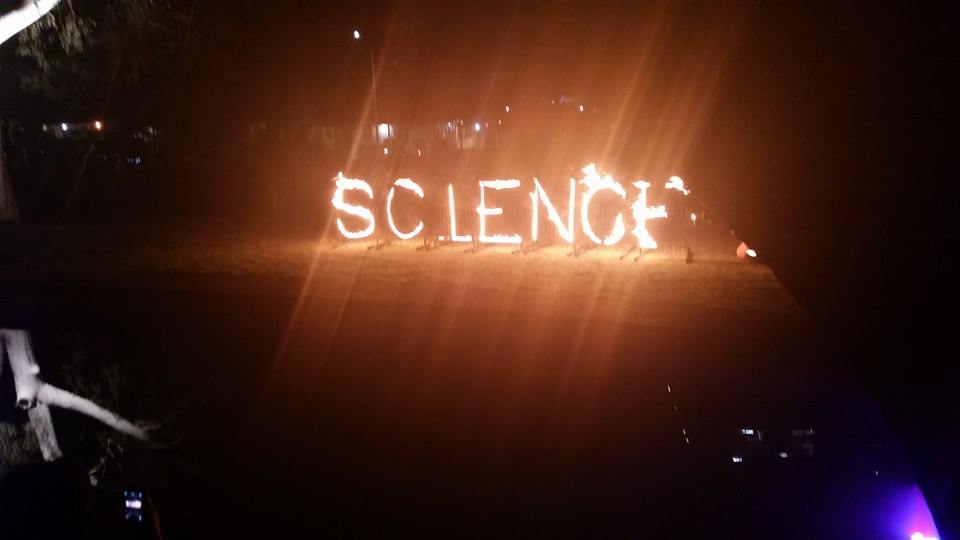22nd August 2014
<< Previous Day Week view Next Day >>
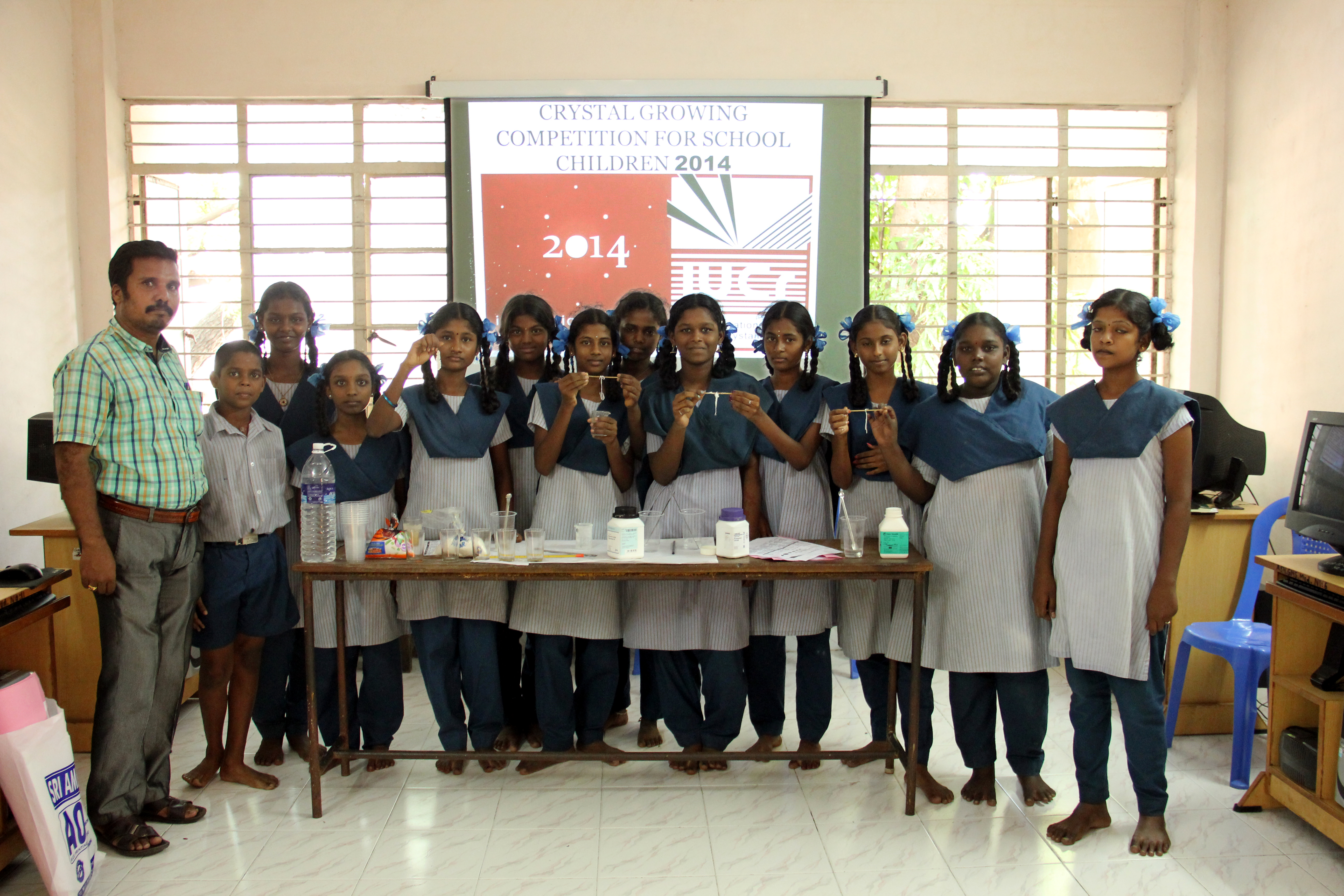
| Event Name | An experiment on crystallography |
| Start Date | 4th Mar 2014 9:00am |
| End Date | 30th Nov 2014 4:00pm |
| Duration | 271 days and 7 hours |
| Description | Many initiatives have been and are being organized to involve schoolchildren at Mudaliarpet, Pondicherry (India) into crystallography on the occasion of IYCr2014. 1. At first, the students were given a brief introduction on various crystals, which made them think about how crystals are formed. 2. Following this, a team of students were selected for a project on Crystal Growth - investigating the size, shape and number of crystals formed, taking various substances such as table salt, sugar, epsom salt, borax, potassium nitrate and alum. 3. A Radio Talk was given by the teacher and the students on the "International Year of Crystallography". 4. A lecture was given on the topic to the school students, following which a demonstration -cum- exhibition, along with a poster presentation by the teacher is to be arranged for view for the public around the school locale. 5. A next attempt to telecast the above in the television is made. 6. Students of our school are participating in the IYCr2014 Crystal Growing Competition. |
| Location | Mudaliarpet, Pondicherry India |
| Contact | Aravindaraja Devadoss aravind.devadoss@gmail.com |
| URL | asngmsmudaliarpet2011.blog.com |
| Category | activities for schoolchildren |
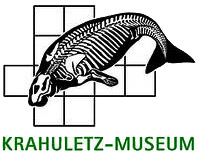
| Event Name | Aus der Mineraliensammlung des Krahuletz-Museum in Eggenburg: Neufunde – Neuerwerbungen – Schätze der Studiensammlung |
| Start Date | 18th Jun 2014 |
| End Date | 31st Dec 2014 |
| Duration | 197 days and 1 hour |
| Description |
Eine neue Kluft im Steinbruch Eibenstein lieferte beachtliche Kalzitkristalle, z.T. Phantombildungen und Kalzite in Chalcedon. Aus Motlas O.Ö. wurden herrliche Quarz-Stufen, Andalusit, Beryll, Schörl und Orthoklas angekauft. In der Mittelvitrine werden aus der Studiensammlung des Museum besondere Stufen ausgestellt: Einzel-Quarzkristalle und Stufen (auch Amethyst), sowie seltene Mineralien wie Amstallit, bzw. aus dem Fundort Kottaun; ferner Beryll, Chalcedon, Schörl u.a. Ebenso wurde der größte Feldspatkristall Österreichs aus Wanzenau bei Rosenburg dem Krahuletz-Museum übergeben und ist dort im Rahmen der Mineralien-Dauerausstellung zu sehen. |
| Location | Eggenburg Austria |
| Contact | Herta Effenberger herta.silvia.effenberger@univie.ac.at |
| URL | http://www.krahuletzmuseum.at/sonderausstellungen.html |
| Category | exhibitions |

| Event Name | Crystallography Display for IYCr2014 |
| Start Date | 19th Mar 2014 2:00pm |
| End Date | 25th Oct 2014 4:00pm |
| Duration | 220 days and 1 hour |
| Description | A small display of minerals at the Diss Museum (Norfolk, England), specially chosen to link with the International Year of Crystallography.
In addition there are minerals exhibiting special features including pyrite, sphalerite, magnetite, fluorspar, gypsum and rhodochrosite, some of which come from the famous 'Trepča' lead/zinc mine near Kosovo Mitrovica in Kosovo. Opening times (19th March to 25th October): |
| Location | Diss, Norfolk United Kingdom |
| Contact | Peter Perkins pjperkins@live.co.uk |
| URL | http://www.disscommunity.net |
| Category | exhibitions |
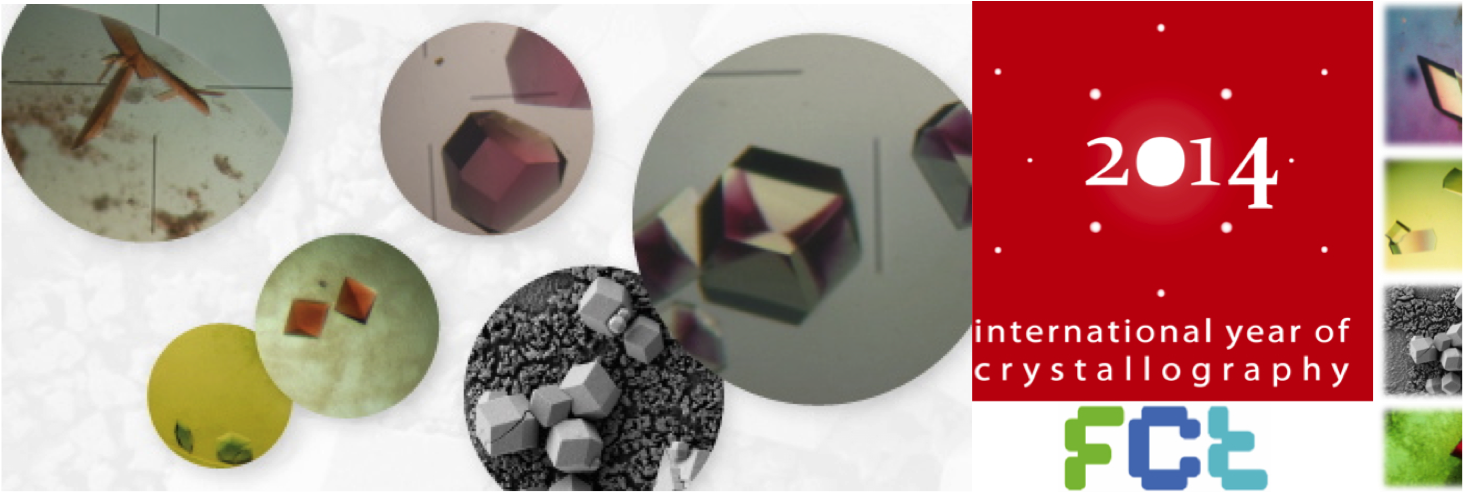
| Event Name | Crystallography for Humankind |
| Start Date | 23rd Jun 2014 |
| End Date | 23rd Dec 2014 |
| Duration | 184 days and 1 hour |
| Description | From June to December 2014 an exhibit related to the celebrations for the International Year of Crystallography entitled "Crystallography for Humankind" will be on view at the FCT-NOVA (entrance of Building VII).
The opening is scheduled on June 23rd, with the presence of Professor Robert Huber, Nobel Laureate in Chemistry. The results of the Photo Contest will be announced. |
| Location | Caparica Portugal |
| Contact | Ana Luisa Carvalho almc@fct.unl.pt |
| URL | http://xtal.dq.fct.unl.pt/iycr2014 |
| Category | exhibitions |

| Event Name | Crystallography in everyday life"- Travelling photo-Exhibition |
| Start Date | 12th Jun 2014 |
| End Date | 27th Oct 2014 |
| Duration | 138 days and 1 hour |
| Description |
The 15 stunning images celebrate the wonder of crystallography, symmetry and crystals as symbolized in the places, objects and experiences of everyday life and will now form part of the traveling exhibition around Australia. Graziano Lolli from Italy won the first prize in this category with a photo of "romanesco broccoli". |
| Location | Australia Australia |
| Contact | Poulomi Agrawal poulomi.agrawal@science.org.au |
| URL | http://www.science.org.au/crystallography-everyday-life-travelling-photo-exhibition |
| Category | exhibitions |
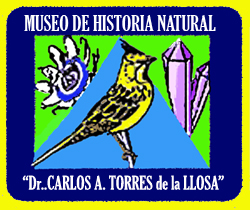
| Event Name | Exhibición Especial de Cristales y Estructuras, Crystals and strucures special exhibit |
| Start Date | 19th May 2014 |
| End Date | 31st Dec 2014 |
| Duration | 227 days and 1 hour |
| Description | El Museo de Historia Natural "Dr. Carlos A. Torres de la Llosa" de Montevideo, Uruguay ha realizado una exhibición especial de Cristales y Estructuras Cristalinas aprovechando su colección de minerales para celebrar el Año Internacional de la Cristalografía 2014. En la exposición se agregan a los minerales algunas figuras con las estructuras atómicas correspondientes. ---- The Natural History Museum "Dr. Carlos A. Torres de la Llosa" of Montevideo, Uruguay has created a special exhibit of Crystals and Crystal structures using its own minerals collection to celebrate the International Year of Crystallography 2014. The exposition contains some figures with the atomic structures of the selected minerals. |
| Location | Montevideo Uruguay |
| Contact | Leopoldo Suescun leopoldo@fq.edu.uy |
| URL | https://sites.google.com/site/museotorresdelallosa/ano-internacional-de-la-cristalografia |
| Category | exhibitions |
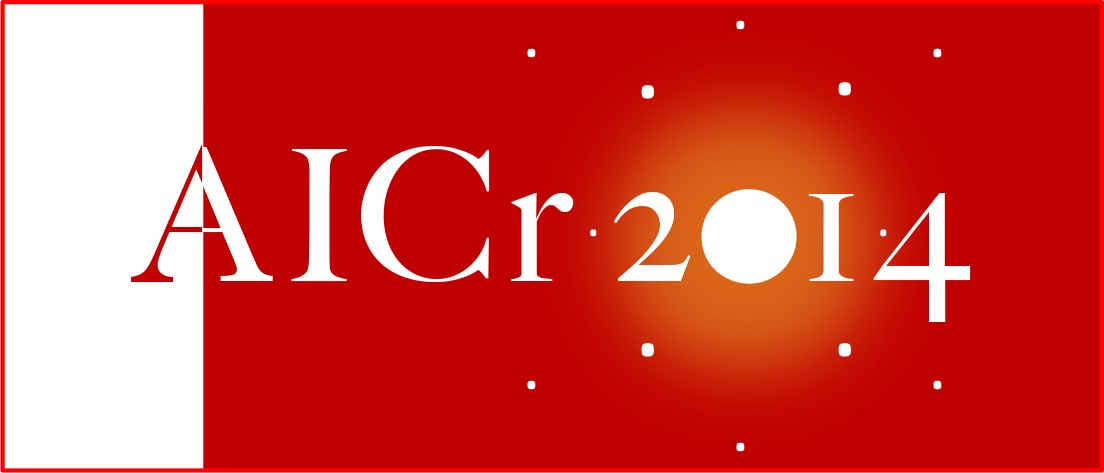
| Event Name | Exhibition "Gemmes, une brillante histoire" ("Gems, a bright story") |
| Start Date | 6th Jul 2014 |
| End Date | 5th Oct 2014 |
| Duration | 92 days |
| Description | The exhibition "Gemmes, une brillante histoire" ("Gems, a bright story") will look like a trip to the heart of the history of gems from the Middle Ages to the nineteenth century, at the option of paintings, prints, art objects >, manuscripts and crystals into three thematic courses:
- Man, crystal, pearl and coral: myths and symbols - King, Prince and Bishop: gems in majesty - the science of gems Many events will be organized around the exhibition: concerts, conferences, demonstrations, ...
More information at http://www.aicr2014.fr and http://www.musee-saint-antoine.fr |
| Location | Musée de Saint-Antoine-l’Abbaye France |
| Contact | Marc Blanchard contact@aicr2014.fr |
| URL | http://www.aicr2014.fr/index.php/agenda/icalrepeat.detail/2014/07/06/97/78|79|80|81/exposition-gemmes-une-brillante-histoire |
| Category | exhibitions |
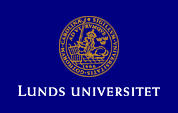
| Event Name | Lattices and invisible rays |
| Start Date | 9th May 2014 |
| End Date | 12th Sep 2014 |
| Duration | 127 days |
| Description | The University library at Lund University celebrates the International Year of Crystallography by hosting a book exhibition displaying a wide plethora of scientific works ranging from the 15th Century up to present time. Focus will be on man's fascination of crystals, the discoveries of Röntgen, Laue and the Braggs, plus local crystallographers and the new MAX IV Laboratory currently under construction in Lund.
The exhibition will open on May 9th with a speech by Sven Lidin, Professor of Inorganic Chemistry at Lund University and Chairman of the Nobel Committee for Chemistry. |
| Location | Lund Sweden |
| Contact | Kristian Knutsson kristian.knutsson@ub.lu.se |
| URL | http://www.ub.lu.se/o.o.i.s/5311 |
| Category | exhibitions |

| Event Name | Living with crystals |
| Start Date | 13th Feb 2014 6:00pm |
| End Date | 11th Jan 2015 6:00pm |
| Duration | 332 days |
| Description | The exhibition "Living with crystal" (original title in Slovenian: Živeti s kristali), organized on the occasion of the International Year of Crystallography, will be open from 13 February 2014 to 11 January 2015 at the Slovenian Museum of Natural History, Ljubljana. On display: Photographs of minerals, Crystal drawings, Mineral and crystal collections, Jewellery, Fluorescent minerals, Interactive presentation of minerals and rocks on Biedermeier tables, Interactive play "Umek the Mineralogist", Microscopic world of crystals. Authors: Miha Jeršek, Mirjan Žorž, Breda Činč Juhant, Katarina Fuchs |
| Location | Prirodoslovni muzej Slovenije, Ljubljana Slovenia |
| Contact | Breda Èinè Juhant bjuhant@pms-lj.si |
| URL | http://www.pms-lj.si/si/razstave/obcasne-razstave/634 |
| Category | exhibitions |

| Event Name | National Science Week | ||||||
| Start Date | 16th Aug 2014 | ||||||
| End Date | 24th Aug 2014 | ||||||
| Duration | 9 days | ||||||
| Description | National Science Week is Australia’s annual celebration of science and technology. Running each year in August, it features approximately 1000 events around Australia, including those delivered by universities, schools, museums and science centres. These events attract a wide audience from children to adults, and science amateurs to professionals. Over one million people participate in science events across the nation. Now into its 16th year, National Science Week provides an opportunity to acknowledge the contributions of Australian scientists to the world of knowledge. It also aims to encourage an interest in science pursuits among the general public, and to encourage younger people to be fascinated by the world we live in. Here are some photos from the crystals display at the Launch of National Science Week at the Shine Dome, Australian Academy of Science, Canberra, which was held on Thursday 14th August 2014. Kids had 6 weeks to grow crystals during May/June and all crystals were submitted in July. The announcements of all winners was made on 20 August during the National Science Week and the Awards giving ceremony will be on August 30th during the University of Canberra open day.
See also information about the ACT Crystal Growing Competition. National Science Week is supported by the Australian Government in a variety of ways. Other partners include the Commonwealth Scientific and Industrial Research Organisation (CSIRO), the Australian Broadcasting Corporation (ABC) and the Australian Science Teachers Association (ASTA). |
||||||
| Location | Canberra Australia |
| Contact | Ashraf Ghanem Ashraf.Ghanem@canberra.edu.au |
| URL | http://www.scienceweek.net.au/ |
| Category | activities for schoolchildren |
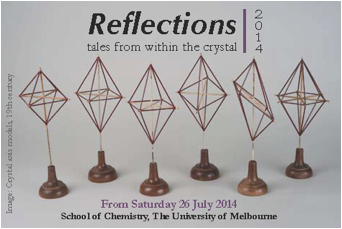
| Event Name | Reflections: tales from within the crystal |
| Start Date | 26th Jul 2014 10:00am |
| End Date | 29th Aug 2014 5:00pm |
| Duration | 34 days and 7 hours |
| Description | Reflections: tales from within the crystalSchool of Chemistry, The University of Melbourne, Parkville, Victoria, AustraliaCrystals have long captivated humankind, from ancient healing remedies and myth and legend, to modern fashion trends and industrial applications. Scientific interest in crystals was piqued over 400 years ago by Johann Kepler who detailed the beautiful symmetry of ice crystals. By the 20th century, scientists discovered that X-rays could be used to determine the arrangement of the atoms which comprise the crystal, creating the field of Crystallography. This exhibition celebrates the International Year of Crystallography bringing together crystal specimens, models and instruments used throughout history to solve the mysteries that lie within the crystal. |
| Location | Melbourne Australia |
| Contact | Renee Beale r.beale@unimelb.edu.au |
| URL | http://www.chemistry.unimelb.edu.au/news/crystallography-exhibition-open-late-july |
| Category | exhibitions |
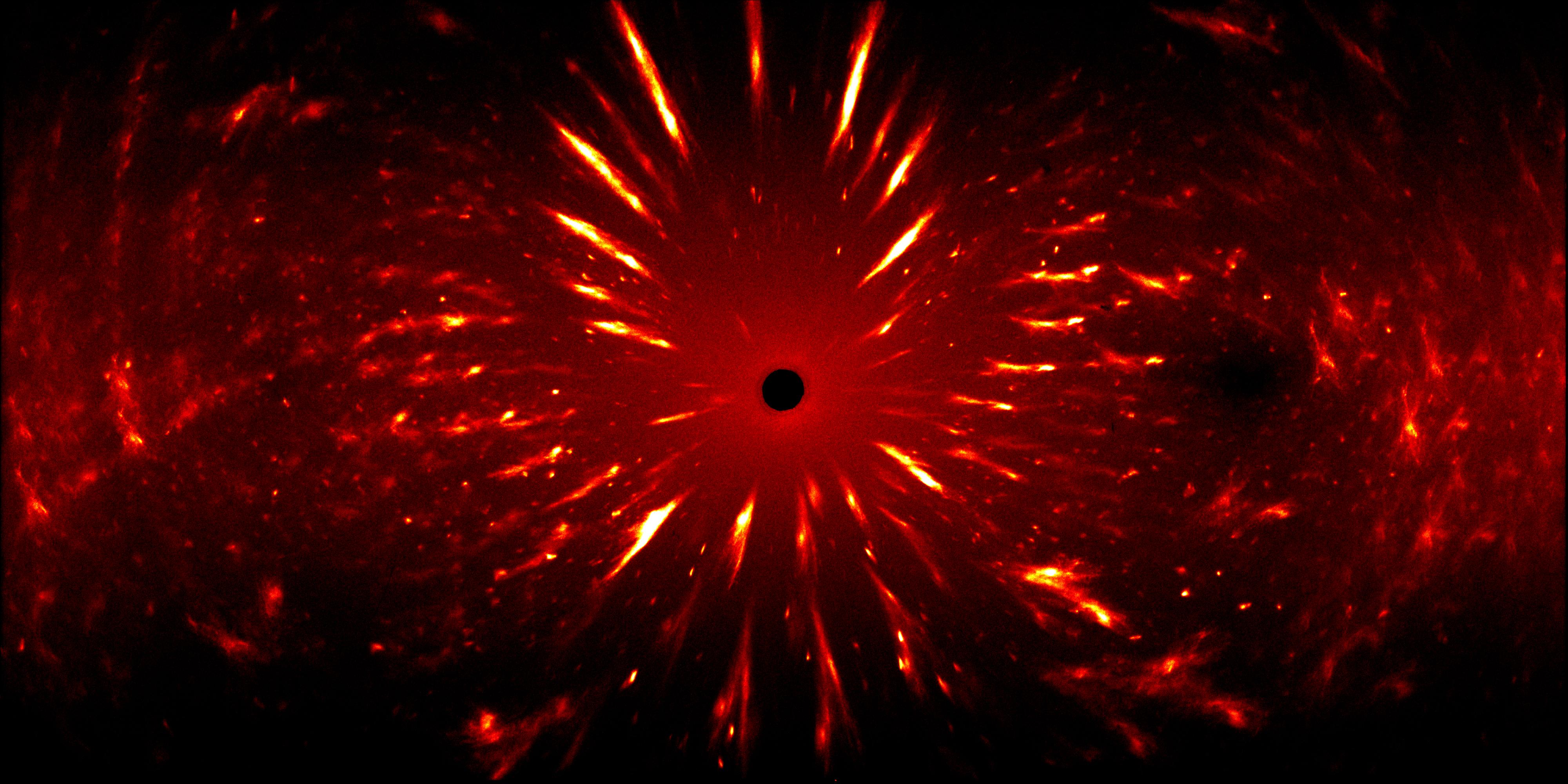
| Event Name | Representations of Matter in Real and Reciprocal Space: Images and Objects from Crystallography |
| Start Date | 15th Aug 2014 |
| End Date | 22nd Aug 2014 |
| Duration | 8 days |
| Description | This exhibition at the University of Sydney’s Verge Gallery will consist of images and objects derived from both diffraction patterns and crystal structures. It will focus on the different ways of representing crystals – in both real and reciprocal space – and their relationship to the practical uses of crystalline materials. As scientists we tend to consider such images and objects as utilitarian or even banal, but occasions such as IYCr remind us that the general public often sees them as intricate and beautiful. We are designing this exhibit to highlight the aesthetics of crystallographic images while also explaining to the audience (in layman’s terms) more complex but fascinating subjects such as modulated structures, quasicrystals, short-range order (diffuse scattering) and magnetic structures. |
| Location | Sydney Australia |
| Contact | Chris Ling chris.ling@sydney.edu.au |
| URL | |
| Category | exhibitions |

| Event Name | Virtual Conference on Computational Chemistry |
| Start Date | 1st Aug 2014 |
| End Date | 31st Aug 2014 |
| Duration | 31 days |
| Description | The first Virtual Conference on Computational Chemistry (VCCC-2013) was held from 1st to 31st August 2013. Following the success of this conference, we are now planning for the second virtual conference, VCCC-2014, from 1st to 31st August 2014. Chemistry is no more about test-tubes and experiments but it also involves the use of efficient and accurate computational methods. This virtual conference will also be held as part of the International Year of Crystallography. Computational chemistry is also used to complement research involving crystallography. ICT can be used effectively for conferences and thus, virtual conferences have gained popularity. The major advantage of virtual conference is the lower cost involved for participation. One simply has to have access to the Internet or email to be involved in the conference. |
| Location | Virtual India |
| Contact | ponnadurai ramasami ramchemi@intnet.mu |
| URL | http://sites.uom.ac.mu/vccc2014/ |
| Category | conferences |

| Event Name | RACI Tasmania Branch Public Lecture: What is X-ray Crystallography and how did it transform our view of the world? |
| Start Date | 22nd Aug 2014 6:00pm |
| End Date | 22nd Aug 2014 7:00pm |
| Duration | 1 hour |
| Description | To celebrate 2014 as the International Year of Crystallography, The Royal Australian Chemical Institute - Tasmania Branch, is hosting a public lecture entitled "What is X-ray Crystallography and how did it transform our view of the world?" on 22 August 2014, 6pm, Chemistry Building, Lecture Theatre 1, University of Tasmania - Sandy Bay Campus (map).
Just over a hundred years ago a narrow beam of X-rays was fired at a crystal for the very first time. The experiment, an early attempt to investigate the nature of this recently discovered radiation, showed that it was wavelike and so constituted a new type of light. Although that was in itself a profound discovery, scientists realised immediately that the far more interesting outcome of the experiment was the revelation that X-rays could be used to 'see' the atomic structure of matter in three dimensions at a level of detail beyond the reach of even the most powerful microscopes. Stephen Curry, a native of Northern Ireland, is a Professor of Structural Biology at Imperial College where he teaches life sciences students at undergraduate and postgraduate level. His main research interests currently are in structural analysis — mainly using X-ray crystallography— of the molecular basis of replication RNA viruses such as foot-and-mouth disease virus and noroviruses (which include the infamous ‘winter vomiting bug’). |
| Location | Hobart Australia |
| Contact | Dr Nathan Kilah Nathan.Kilah@utas.edu.au |
| URL | http://www.raci.org.au/branches/tas-branch-2 |
| Category | lectures |
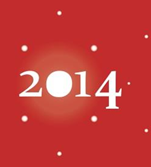


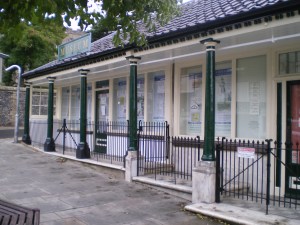 Minerals have been selected that exhibit their crystalline form to illustrate some basic laws: the work of Nicolas Steno and the law of the constancy of facial angles (using quartz) and Réne Haüy's geometrical law of crystallization (using calcite and galena).
Minerals have been selected that exhibit their crystalline form to illustrate some basic laws: the work of Nicolas Steno and the law of the constancy of facial angles (using quartz) and Réne Haüy's geometrical law of crystallization (using calcite and galena).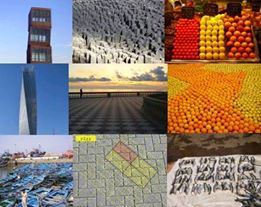 The Australian satellite of the IYCr2014 photo competition
The Australian satellite of the IYCr2014 photo competition 